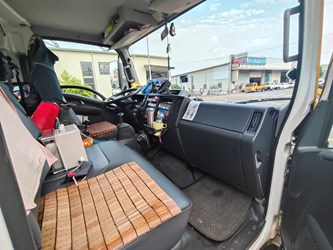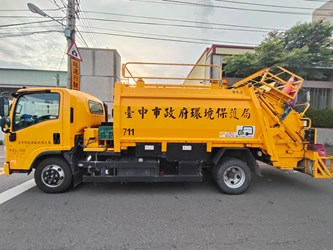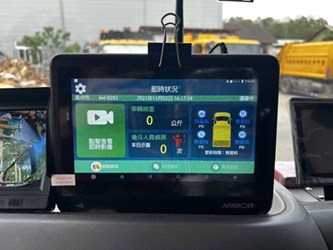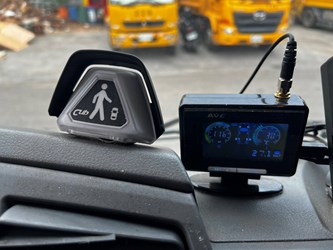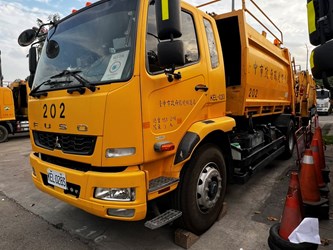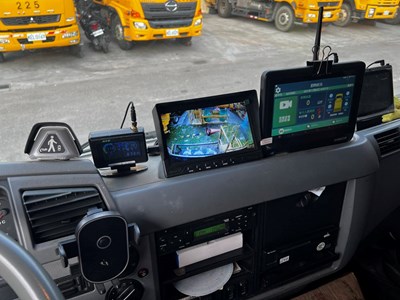
The Environmental Protection Bureau of Taichung City Government has launched a pilot program introducing smart garbage trucks equipped with a “Smart Safety Management Platform” powered by AIoT (Artificial Intelligence of Things) technology. This platform integrates features such as Driver Monitoring System (DMS), Advanced Driver Assistance System (ADAS), and Blind Spot Detection (BSD), which provide real-time alerts to drivers about fatigue, unsafe following distances, and inattentive driving. It also transmits abnormal conditions and road status information to the backend system, significantly enhancing driving safety.
The Environmental Protection Bureau explained that the introduction of the Smart Safety Management Platform for garbage collection vehicles is part of the “Smart City and Rural Life Application Subsidy Program” by the Administration for Digital Industries under the Ministry of Digital Affairs. Through this initiative, AIoT technology is integrated into “smart connected sanitation vehicles,” combining all onboard connected devices to transmit various sensor signals, driving footage, and data to the backend management system. Leveraging mobile communication’s high bandwidth and low latency, the system effectively enhances driving safety.
The Environmental Protection Bureau is currently piloting the integration of a smart safety management system into garbage trucks used by sanitation teams. Key features include the Driver Monitoring System (DMS), which provides real-time voice alerts if the driver shows signs of fatigue, distraction, or is using a phone. The Advanced Driver Assistance System (ADAS) offers alerts for situations such as following too closely or lane departure. Any abnormal conditions are sent instantly to the information platform, and the in-cabin tablet allows drivers to report road conditions—such as traffic accidents or road construction—in real time so that support vehicles can be quickly dispatched.
In addition, the load detection system helps managers monitor changes in the vehicle’s daily weight, allowing them to optimize collection routes. The rear personnel detection system alerts the driver if someone is in the back of the vehicle, prompting slower and safer driving. The Blind Spot Detection (BSD) system uses infrared sensors to detect wheel sweep and blind spots, significantly improving safety and reducing the risk of collisions during lane changes or other maneuvers.
A driver from the North District Sanitation Team shared that whenever their eyes stray from the road ahead, a voice alert saying “Please pay attention to driving” is triggered. Since garbage trucks often collect waste curbside and must stay to the right, the ADAS frequently issues lane departure warnings. It also notifies the driver of speeding or if following distance is too close. Because garbage trucks are specialized vehicles with high driver seating, it’s harder to detect nearby pedestrians or vehicles in blind spots, especially when turning. When the system senses anything entering the alert zone—such as pedestrians or other vehicles—it sounds an alert to keep the driver vigilant. This enhances safety for both the driver and accompanying personnel by continuously reminding them of road safety and helping prevent accidents.
A driver from the Xitun District Sanitation Team, who has over ten years of experience operating garbage trucks, noted a significant improvement in safety with the new smart-connected equipment. In the past, they had to watch the road ahead and behind while also keeping an eye on the rear loading area, making it easy to become momentarily distracted and risk an accident. Now, with built-in systems that detect fatigue and distraction, the vehicle issues voice prompts if the driver begins to lose focus after long periods behind the wheel—greatly enhancing driving confidence and safety.
Environmental Protection Bureau Director Chen Hong-Yi explained that in the past, garbage trucks couldn’t accurately estimate whether they were nearing full capacity during collection. Continuing to operate when overloaded often led to damage to the truck’s rear compartment, resulting in high repair costs and increased fuel consumption and carbon emissions. With the AIoT-based smart safety management platform, real-time monitoring of truck load capacity is possible. This data allows prediction of near-capacity collection points, helping teams plan vehicle dispatching, shift changes, or route adjustments in advance—thus preventing overloading, improving road safety, and reducing delays for residents.
Director Chen also highlighted the benefits of remote monitoring through the smart safety platform, which enables real-time observation of vehicle operations, quick access to incident evidence, and video documentation. The AI image recognition system is being developed to identify illegal waste dumping, while surveillance footage and vehicle camera data can help detect and locate unauthorized advertising on roadside utility poles. The Bureau plans to increase its budget for fiscal year 2026 (Year 115 in the ROC calendar) to integrate digital management for garbage trucks, further expanding the smart applications of these vehicles. The ultimate goal is to digitize fleet operations while enhancing the safety of sanitation workers.

 Facebook
Facebook
 Twitter
Twitter
 LINE
LINE
